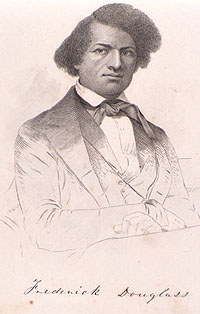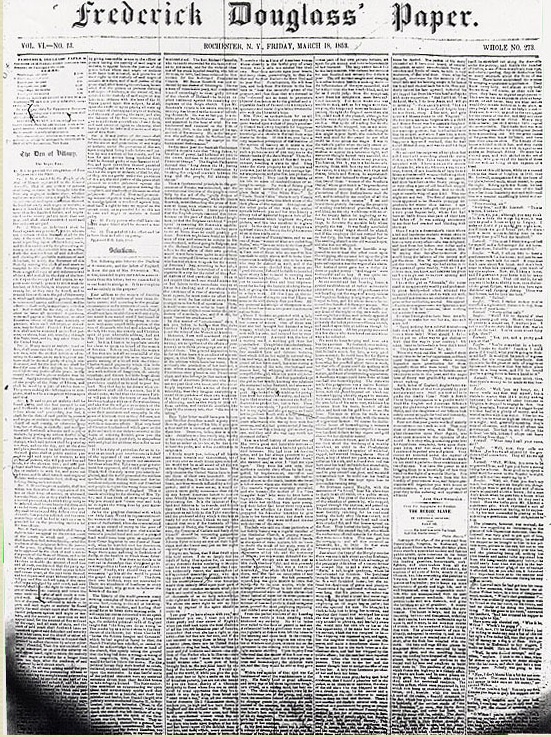
Frederick Douglass’ Paper, 1851 – 1858
Sam Green.
[As reprinted in The Underground Railroad (1872)]
The case of the State against Sam Green (free negro) indicted for having in his possession, papers, pamphlets and pictorial representations, having a tendency to create discontent, &c., among the people of color in the State, was tried before the court on Friday last.
This case was of the utmost importance, and has created in the public mind a great deal of interest—it being the first case of the kind ever having occurred in our country.
It appeared, in evidence, that this Green has a son in Canada, to whom Green made a visit last summer. Since his return to this country, suspicion has fastened upon him, as giving aid and assisting slaves who have since absconded and reached Canada, and several weeks ago, a party of gentlemen from New Market district, went at night, to Green’s house and made search, whereupon was found a volume of “Uncle Tom’s Cabin,” a map of Canada, several schedules of routes to the North, and a letter from his son in Canada, detailing the pleasant trip he had, the number of friends he met with on the way, with plenty to eat, drink, &c., and concludes with a request to his father, that he shall tell certain other slaves, naming them, to come on, which slaves, it is well known, did leave shortly afterwards, and have reached Canada. The case was argued with great ability, the counsel on both sides displaying a great deal of ingenuity, learning and eloquence. The first indictment was for having in possession the letter, map and route schedules.
Notwithstanding the mass of evidence given, to show the prisoner’s guilt, in unlawfully having in his possession these documents, and the nine-tenths of the community in which he lived, believing that he had a hand in the running away of slaves, it was the opinion of the court, that the law under which he was indicted, was not applicable to the case, and that he must, accordingly, render a verdict of not guilty.
He was immediately arraigned upon another indictment, for having in possession “Uncle Tom’s Cabin,” and tried; in this case the court has not yet rendered a verdict, but holds it under curia till after the Somerset county court. It is to be hoped that the court will find the evidence in this court sufficient to bring it within the scope of the law under which the prisoner is indicted (that of 1842, chap. 272), and that the prisoner may meet his due reward—be that what it may.
That there is something required to be done by our Legislators, for the protection of slave property, is evident from the variety of constructions put upon the statute in this case, and we trust, that at the next meeting of the Legislature there will be such amendments, as to make the law on this subject, perfectly clear and comprehensible to the understanding of every one.
In the language of the assistant counsel for the State, “Slavery must be protected or it must be abolished.”
From the same sheet, of May 20th, the terrible doom of Samuel Green, is announced in the following words:
In the case of the State against Sam Green, (free negro) who was tried at the April term of the Circuit Court of this county, for having in his possession abolition pamphlets, among which was “Uncle Tom’s Cabin,” has been found guilty by the court, and sentenced to the penitentiary for the term of ten years—until the 14th of May, 1867.
>via: http://utc.iath.virginia.edu/notices/noar63at.html
__________________________
Frederick Douglass’ first paper was The North Star, which he edited along with Martin Delany and published in Rochester from 1847 to 1851. Financial difficulties led him in 1851 to merge the paper with Gerrit Smith’s Liberty Party Paper and to call the new four-page weeklyFrederick Douglass’ Paper. Smith helped with money, Julia Griffiths, a Rochester abolitionist, volunteered editorial assistance, and William J. Watkins was listed on the masthead as Editorial Assistant, but Douglass had complete editorial control. The first issue appeared 6 June 1851, and the last in 1858, when its place was taken by Frederick Douglass’ Monthly.
Douglass’ Paper was specifically dedicated to the related causes of abolishing slavery and improving the condition of “free colored people in the North.” It also featured stories and editorials on a wide range of liberal reform topics, from temperance to woman’s rights. It paid some attention to local events in and around Rochester, but its real focus, like its readership, was national, or at least Northern. Given Douglass’ rhetorical situation, he gave a surprising amount of room in his columns to the other side, often reprinting Southern or pro-slavery items with little editorial comment. No reader, however, could have missed the paper’s own commitment to attacking instances of injustice or oppression on both sides of the Mason-Dixon Line.
The paper’s basic layout remained fairly constant. Page 1 featured current events involving racial or abolitionist issues. “The Den of Villany” was introduced as a regular feature on 11 March 1853 as a place where Douglass could expose discriminatory practices in American society; it appears in the 18 March issue too, but thereafter appeared irregularly. Pages 2 and 3 were made up of a variety of items: editorials, correspondence from contributors and readers (often other African Americans), poetry, book reviews, short news items. On page 4 were the ads — and, for most of 1853, excerpts from Dickens’ Bleak House that seem mainly intended to help Douglass fill up the paper (though Dickens’ popularity with Americans and his reputation for reform-mindedness make him an appropriate part of the paper’s conversation).
>via: http://utc.iath.virginia.edu/notices/nohp.html#f


